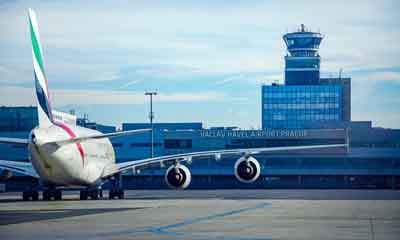Experiencing the ‘Czech spirit’ at Prague Airport
- Like
- Digg
- Del
- Tumblr
- VKontakte
- Buffer
- Love This
- Odnoklassniki
- Meneame
- Blogger
- Amazon
- Yahoo Mail
- Gmail
- AOL
- Newsvine
- HackerNews
- Evernote
- MySpace
- Mail.ru
- Viadeo
- Line
- Comments
- Yummly
- SMS
- Viber
- Telegram
- Subscribe
- Skype
- Facebook Messenger
- Kakao
- LiveJournal
- Yammer
- Edgar
- Fintel
- Mix
- Instapaper
- Copy Link
Posted: 3 January 2023 | Jaroslav Filip | No comments yet
Jaroslav Filip, Aviation Business Director at Prague Airport outlines how, despite the challenges faced within aviation over the past couple of years, passengers continue to travel to one of the world’s top 10 travel destinations; the captivating country that is the Czech Republic and its capital city, Prague.


How did the COVID-19 pandemic impact your airport operations? How are things going for the airport now?
It is great to see our traffic resume. Last summer season, our passenger volumes returned to 65 per cent of pre-COVID-19 numbers, whereas outgoing from Prague Airport was much stronger when it reached nearly 100 per cent of pre-COVID-19 figures. When governments relaxed the travel and lockdown restrictions, we were able to see immediately the evident return in demand.
With Václav Havel Airport Prague being at the centre of Europe, we are facing challenges related to the war in Ukraine and a lack in passenger traffic from Ukraine and Russia. Furthermore, last summer, we continued to see a decrease in traffic from our Asian passenger markets as strong COVID-19 restrictions prevailed there during the entire season. But again, as Asian countries are currently lifting restrictions, we can see an immediate increase in the incoming demand. Currently, the best examples may be Thailand alongside the still strengthening outgoing demand from the Czech Republic as a whole.
In 2019, and before the ‘great pandemic’ hit, we were reporting over 17.8 million passengers travelling through Prague Airport. We will highly likely exceed a total of 10 million passengers at the end of 2022, which is around 60 per cent of pre-pandemic (2019) volumes and slightly above our predictions from the beginning of the year.
Has your passenger demographic shifted?
With Prague being the beautiful capital of the Czech Republic, our incoming traffic has almost always been leisure driven. In fact, Prague is one of the top 10 destinations in the world for travellers to visit. Visiting Friends and Relatives (VFR) is not a key driver for passenger traffic in the Czech Republic.
On the other hand, outbound tourism has changed during the last two years. It is stronger than it was in previous years. The proof was the speed of recovery, but also, for example, the higher share of Czech clients travelling between the USA and the Czech Republic in 2022. On the contrary, in 2019, it was U.S. passengers dominating the travel market between Prague and America, especially on direct flights. We are very happy for such development and want to continue to support
What is Prague Airport’s route development strategy?
We would like to become the destination of choice for passengers travelling between Prague and Western Europe, North America, and Asia. Our airport also used to be very well connected with Russia and the Commonwealth of Independent States (CIS) countries. Now, we can see strong incoming traffic from France, Spain, and finally the UK, which was our strongest market back in 2019. The resumed Delta Air Lines direct connection from Prague to New York was enormously successful during last summer, which is the proof that we have to insist on our effort to strengthen direct connections with North America as one of our top priorities. Looking to the future, we hope to connect Prague with Chicago, as well as Florida in the U.S. We would also like to add more capacity from Asia and the Middle East. Before the COVID-19 pandemic, we had a direct connection from Seoul, Incheon, which was served by both Czech Airlines and Korean Air. We can see huge potential in VFR travel between Prague and Hanoi due to our strong Vietnamese community. I believe, the Czech Republic is the home to the third largest Vietnamese community in Europe. Furthermore, I must mention strong demand for Tokyo, Taipei or Delhi connections, our aim to restore direct air connections with China, and, last but not least, to continue developing new direct services from the Middle East. This year, new direct routes were launched from Riyadh, Kuwait, and Oman and there is potential for more.
How will you modify the passenger experience to meet your route development strategy?
It is not just that we put an enormous effort in passenger experience and passenger journey improvements, we are also trying to come up with new products, which would strengthen the attractiveness of Prague Airport especially for long-haul travellers. One of such projects is, for example, the FlyViaPRG product delivered in co-operation with Kiwi.com. It was designed for passengers who are self-connecting from Prague to onward flights without having connecting tickets. These passengers are offered a special service, namely a fast-track lane, self-bag-drop use, discounted business lounges visits or discounts at our retail partner facilities.
Why should an airline fly to your airport, rather than your competitors?
We can offer so much more. We have prepared a new incentive scheme, covering not only increased incentive discounts for new destinations, but also an increased volume-based incentives available from 2023, which, we believe, will motive airlines to allocate more capacity for Prague and launch currently unserved routes.
In addition, we managed to keep the airport charges at the same level for the next year and moreover, our passengers are not subject to any governmental or aviation taxes like in some other countries in the region.
Tell me about your airport, what do passengers experience?
Prague Airport is a simple and accessible airport, where it takes just a five-minute walk to move between terminal one and two. So, particularly for transfer traffic, Prague Airport is extremely accessible. Although, we are a relatively small airport, with only two terminals, we still manage to accommodate almost 19 million passengers annually.
Prague is an iconic destination, so we try to bring the Prague spirit into the airport experience and facilities. For example, when we are looking for new airport services or duty-free providers, we look to those that capture the culture or lifestyle of Prague. Great example is our new shop, which we just opened together with our partner – Lagardére Duty Free – at Terminal 2. It is called Future is Local and it carries almost 30 local and sustainable brands. In our customer experience effort, we also aim at families with children. We have many facilities and services available to them for free. At both terminals, we also have big relax zones where passengers can relax or work shielded from the airport buzz.
How do you work with governments or tourism offices to promote your destination to travellers?
The crucial part of attracting a new airline is not only to focus on our airport incentives but rather on the whole product that we offer. As an airport, once a relationship begins, we do all we can to support the airline and promote the new capacity. We call this co-operation ‘Touchpoint’, which means Prague Airport is at the centre of the support provided for our airline partners servicing new key destinations. The ‘Touchpoint Mission’ involves us, Prague City Tourism, and Czech Tourism. Together, we support our country and region market entry, contribute to the fast resumption of incoming tourism post‑pandemic, promote Prague as an attractive destination for air carriers, and address the topic of sustainable tourism. We also help airlines to get familiar with our market specifics, connect them with tour-operators, agencies and other stakeholders on both sides, in the Czech Republic and abroad.
Demand is the key. Prague Airport, post-pandemic, witnessed a lot of changes. We will provide all the support we can to maintain traffic and airline partnerships. It is up to us to help airlines fill seats and show how thankful we are for them and the capacity they brought to us throughout such challenging times. So, we continue to work with governmental bodies and tourism boards to let the world know that Prague is here, and it is available.
What has been Prague Airport’s cargo journey so far? What’s in store for the future?
We are not a typical cargo airport. However, cargo is definitely an important part of our further development strategy, which we can support with our own incentive programme. We consider ourselves a perfect alternative to the big European cargo hubs that cannot accommodate airlines‘ demand for additional capacity. The cargo terminals at Prague Airport have available capacity and offer efficient cargo handling to an extensive road feeder service network in Western, Central and Eastern Europe.
We recognise that during the pandemic, our cargo operations increased. This has highlighted the notion that we should carry on the support for our cargo carriers. We have discovered that with regions such as Asia and North America cargo operations are a must. Thus, we look forward to adding more cargo carriers and operations in the near future.
What are the three most exciting developments happening at the airport?
First, it is the already mentioned FlyViaPRG project – a key example of how we work with airlines to support our passenger demographics. We have also finished rebuilding our Terminal 3 primarily dedicated to general aviation business operation. Alongside this, we still have plans for the Terminal 2 extension in place.
What is your business outlook for the future?
I believe that we will continue to accommodate and attract more airlines, with the aim to raise capacity levels as soon as possible. Prague Airport would also love to welcome new destinations, especially long‑haul carriers, and routes. We belong among the top 10 destinations to visit in Europe, and we intend to stay there.


Related topics
Air freight and cargo, Airport development, Capacity, Cargo, COVID-19, Passenger experience and seamless travel, Passenger volumes, Tourism


















